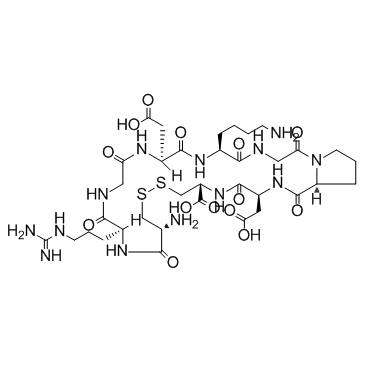| Description |
iRGD peptide is a 9-amino acid cyclic peptide, triggers tissue penetration of drugs by first binding to av integrins, then proteolytically cleaved in the tumor to produce CRGDK/R to interact with neuropilin-1, and has tumor-targeting and tumor-penetrating properties.
|
| Related Catalog |
|
| Target |
Integrin[1]
|
| In Vitro |
iRGD peptide-mediated tumor penetration occurs in three steps: binding to αv-integrins on tumor vasculature or tumor cells, exposure by proteolysis of a C-terminal motif that binds to neuropilin-1 (NRP-1) and cell internalization. iRGD peptide inserted in the ICOVIR15K fiber C terminus enhances binding and internalization only in MCF7 cells, which express NRP-1 and integrins. iRGD insertion does not impair virus infection and replication[1]. iRGD peptide alone has no obvious effect on gastric cancer cells, and when combined with 5-FU, iRGD peptide (0.3 μmol/mL) enhances the chemotherapy efficacy of 5-FU on gastric cancer cells through NRP1[2].
|
| In Vivo |
iRGD inserted in the oncolytic adenovirus ICOVIR15K (ICOVIR15K-iRGD) enhances early adenovirus dissemination through the tumor mass and elevates the antitumor effect in mice[1]. iRGD (4 mmol/kg, i.v.) in combination with 5-FU significantly suppresses the tumor growth in nude mice bearing human gastric cancer cells[2].
|
| Animal Admin |
Mice[2] 12 male BALB/c nude mice (4-week-old) are assigned to 4 groups with 3 mice in each group. Among them,two groups are subcutaneously injected into the flanks by 3 × 106 HCG27 cells, the other two groups are conducted by NCI-N87 cells. Experimental groups are intravenously injected by 5-FU (25 mg/kg) mixed with iRGD peptide (4 mmol/kg) at every three days for 4 weeks while control groups are treated by 5-FU (25 mg/kg) mixed with PBS. And tumor volume is computed every 1 week with a digital vernier caliper using the following formula: tumor volume = (length × width2)/2[2].
|
| References |
[1]. Puig-Saus C, et al. iRGD tumor-penetrating peptide-modified oncolytic adenovirus shows enhanced tumor transduction, intratumoral dissemination and antitumor efficacy. Gene Ther. 2014 Aug;21(8):767-74. [2]. Zhang L, et al. Combination of NRP1-mediated iRGD with 5-fluorouracil suppresses proliferation, migration and invasion of gastric cancer cells. Biomed Pharmacother. 2017 Sep;93:1136-1143.
|


